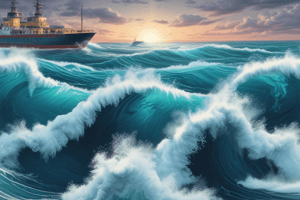Podcast
Questions and Answers
What characterizes the equatorial Walker circulation during normal conditions in the tropical Pacific?
What characterizes the equatorial Walker circulation during normal conditions in the tropical Pacific?
- East-West sea surface temperature gradient driving circulation (correct)
- Intense drought conditions in the eastern Pacific
- High pressure over the western Pacific and low pressure over the eastern Pacific
- Uniform sea surface temperatures across the equator
How does the El Nino phenomenon primarily affect global temperature?
How does the El Nino phenomenon primarily affect global temperature?
- It leads to an increase in global surface temperatures. (correct)
- It stabilizes global temperatures at a consistent level.
- It has no significant impact on global temperatures.
- It decreases global temperatures significantly.
What is a significant consequence of El Nino on rainfall patterns?
What is a significant consequence of El Nino on rainfall patterns?
- Increased rainfall in Indonesia and surrounding regions
- Dry conditions in Indonesia with higher occurrence of drought and fires (correct)
- Global rainfall becomes entirely predictable
- Consistent rainfall distribution across all regions
Which phenomenon is characterized by unusual cooling patterns following El Nino?
Which phenomenon is characterized by unusual cooling patterns following El Nino?
What role does atmospheric circulation play during El Nino events?
What role does atmospheric circulation play during El Nino events?
What happens to anthropogenic carbon emissions during El Nino events?
What happens to anthropogenic carbon emissions during El Nino events?
Which of the following is a known impact of El Nino on Southeast Asia?
Which of the following is a known impact of El Nino on Southeast Asia?
What describes the El Nino-Southern Oscillation (ENSO)?
What describes the El Nino-Southern Oscillation (ENSO)?
How does NPP vary during the El Niño and La Niña phases?
How does NPP vary during the El Niño and La Niña phases?
Which factor is primarily responsible for seawater density?
Which factor is primarily responsible for seawater density?
What primarily drives surface ocean currents?
What primarily drives surface ocean currents?
What effect does the Coriolis effect have on subtropical gyres?
What effect does the Coriolis effect have on subtropical gyres?
What is the main driver of deep-ocean overturning thermohaline circulation?
What is the main driver of deep-ocean overturning thermohaline circulation?
Which phenomenon is considered the most significant climate fluctuation over year-to-year timescales?
Which phenomenon is considered the most significant climate fluctuation over year-to-year timescales?
Which cycles should be focused on in relation to human impacts as per the assigned reading?
Which cycles should be focused on in relation to human impacts as per the assigned reading?
How are biogeochemical cycles connected to climate control?
How are biogeochemical cycles connected to climate control?
What primarily drives the ocean surface currents?
What primarily drives the ocean surface currents?
Which process leads to higher sea levels in gyre centers?
Which process leads to higher sea levels in gyre centers?
What effect does the Coriolis effect have on ocean currents in the Northern Hemisphere?
What effect does the Coriolis effect have on ocean currents in the Northern Hemisphere?
What contributes to the formation of deep ocean currents?
What contributes to the formation of deep ocean currents?
In terms of ocean circulation, what is the role of upwelling?
In terms of ocean circulation, what is the role of upwelling?
What is the term for the global oceanic circulation driven by density differences?
What is the term for the global oceanic circulation driven by density differences?
What primarily determines the structure of ocean gyres?
What primarily determines the structure of ocean gyres?
Which water mass forms predominantly in the North Atlantic region?
Which water mass forms predominantly in the North Atlantic region?
What effect does basin shape have on ocean currents?
What effect does basin shape have on ocean currents?
Which of the following is NOT a characteristic of Ekman transport?
Which of the following is NOT a characteristic of Ekman transport?
How does temperature influence deep ocean currents?
How does temperature influence deep ocean currents?
What nutrient cycle is associated with upwelling zones?
What nutrient cycle is associated with upwelling zones?
What happens to currents as they deepen in the ocean?
What happens to currents as they deepen in the ocean?
Flashcards
Surface ocean currents
Surface ocean currents
The movement of the ocean's surface water driven primarily by winds.
Ocean Gyres
Ocean Gyres
Large-scale, circular ocean currents driven by the combination of winds, Coriolis effect, and water density.
Coriolis Effect
Coriolis Effect
The deflection of a moving object to the right in the Northern Hemisphere and to the left in the Southern Hemisphere due to Earth's rotation.
Ekman spiral
Ekman spiral
Signup and view all the flashcards
Ekman transport
Ekman transport
Signup and view all the flashcards
Upwelling
Upwelling
Signup and view all the flashcards
Thermohaline Circulation (THC)
Thermohaline Circulation (THC)
Signup and view all the flashcards
Deep water formation
Deep water formation
Signup and view all the flashcards
North Atlantic Deep Water (NADW)
North Atlantic Deep Water (NADW)
Signup and view all the flashcards
Antarctic Bottom Water (AABW)
Antarctic Bottom Water (AABW)
Signup and view all the flashcards
Bathymetry
Bathymetry
Signup and view all the flashcards
Plate tectonics
Plate tectonics
Signup and view all the flashcards
Geostrophic balance
Geostrophic balance
Signup and view all the flashcards
Western Boundary Current
Western Boundary Current
Signup and view all the flashcards
Deep Ocean Circulation
Deep Ocean Circulation
Signup and view all the flashcards
What is the Walker Circulation?
What is the Walker Circulation?
Signup and view all the flashcards
What is El Niño?
What is El Niño?
Signup and view all the flashcards
What is La Niña?
What is La Niña?
Signup and view all the flashcards
How does El Niño affect global temperatures?
How does El Niño affect global temperatures?
Signup and view all the flashcards
How does El Niño affect global rainfall patterns?
How does El Niño affect global rainfall patterns?
Signup and view all the flashcards
What are tele-connections in El Niño?
What are tele-connections in El Niño?
Signup and view all the flashcards
How does El Niño affect carbon emissions?
How does El Niño affect carbon emissions?
Signup and view all the flashcards
How does El Niño affect forest fires in Southeast Asia?
How does El Niño affect forest fires in Southeast Asia?
Signup and view all the flashcards
El Nino-Southern Oscillation (ENSO)
El Nino-Southern Oscillation (ENSO)
Signup and view all the flashcards
Net Primary Productivity (NPP)
Net Primary Productivity (NPP)
Signup and view all the flashcards
El Nino
El Nino
Signup and view all the flashcards
La Nina
La Nina
Signup and view all the flashcards
What determines seawater density?
What determines seawater density?
Signup and view all the flashcards
Thermohaline Circulation
Thermohaline Circulation
Signup and view all the flashcards
Study Notes
Surface Ocean Circulation
- Driven primarily by surface winds in the lower atmosphere
- Density differences (dense water sinking) drive deep ocean circulation (thermohaline)
- Friction between ocean layers creates Ekman spirals
- Coriolis effect deflects currents relative to surface winds
- Bathymetry (ocean floor shape) and basin shape significantly impact currents, though these are mostly fixed now but were different in the past due to plate tectonics.
Surface Currents - Schematic
- Largely driven by surface winds
- Warm currents transport heat poleward (moving energy)
- Basin-scale patterns are called "gyres"
- Illustrated with global map showing various ocean currents and gyres (e.g., North Pacific Gyre, South Pacific Gyre, etc.)
Ekman Transport
- Wind-driven surface currents are deflected by the Coriolis effect (right in the Northern Hemisphere).
- Currents weaken with depth due to friction.
- Further deflection with depth by the Coriolis effect.
- Net Ekman transport is perpendicular to surface wind stress.
- Contributes to convergence and higher sea levels at gyre centers.
Surface Currents - Gyres
- Prevailing winds, basin shape, and geostrophic balance, working together, create gyre structures.
- Net Ekman transport is perpendicular to surface wind stress.
- Leads to convergence and higher sea levels in gyre centers.
- Resulting pressure gradient force is balanced via Coriolis effect. Surface flow is geostrophic.
- A weaker Coriolis effect near the equator results in narrow, strong western boundary currents.
Upwelling
- Diverging surface currents cause upwelling along certain coasts (often in the Southern Hemisphere).
- Upwelling brings nutrient-rich water from deeper depths to the surface.
- Associated with high biological productivity due to the increased nutrients.
Past Surface Ocean Currents
- Bathymetry and basin shapes significantly impact ocean currents.
- Maps showing current patterns during the Late Jurassic (150-200 million years ago) and Early Tertiary (~50 million years ago) are provided.
- Changes in map patterns demonstrates the shifting continents.
Deep Ocean Circulation
- Not discussed in detail in the provided images.
Surface Density
- Dense, cold, and salty water sinks.
- Dense waters significantly contribute to deep ocean overturning circulation
Thermohaline Circulation (THC)
- Driven by deep water formation (density-driven).
- Connected to temperature(thermo) and salinity (haline)
- Arctic deep waters enter the global ocean in the North Atlantic.
- Two key deep water masses formed: North Atlantic Deep Water (NADW) and Antarctic Bottom Water (AABW).
- NADW mainly forms in the North Atlantic, Norwegian, and Greenland Sea regions.
- AABW forms around Antarctica.
THC in Ocean Properties
- Graphs illustrating temperature and salinity variations are provided with depth in the Atlantic Ocean.
- NADW and AABW deep water locations indicated and shown as features of the THC.
The Thermohaline Circulation - Globally
- Circulation patterns are shown on a global map, emphasizing deep and surface currents.
- Deep water masses (NADW, AABW), form and flow throughout the globe.
El Niño Phenomenon
- Characterized by unusual warming in the central and/or eastern Pacific Ocean.
- This impacts the ENSO (El Niño-Southern Oscillation) system.
- This impacts global atmospheric circulation patterns.
Tropical Pacific - Normal Conditions
- East-West sea surface temperature (SST) gradient drives equatorial Walker circulation.
- Trade winds blow westwards.
- Warm surface water piles up in the western Pacific.
- Cold water upwells in the eastern Pacific.
- A coupled ocean-atmosphere system.
El Niño Impacts
- Global surface temperature increase.
- Rainfall anomalies (e.g., droughts in Indonesia).
- Increased fire risk in areas with dry conditions.
- Reduced land sink for atmospheric carbon (meaning more CO2 in the atmosphere).
- Impact on global temperatures are demonstrated by data (like charts).
El Niño and Rainfall Anomalies
- "Tele-connections" in atmospheric circulation are important.
- Maps show rainfall anomalies associated with El Niño events in various locations.
El Niño and Southeast Asian "Haze"
- Lower rainfall combined with land use change leads to fires.
- Atmospheric pollution (haze) increases in Southeast Asia during El Niño events.
- Visibility Reduction data presented in various geographical areas and given for specific times.
ENSO and Carbon Uptake by Land
- ENSO affects Net Primary Production (NPP) in certain regions.
- NPP (larger) during El Niño, and (larger) during La Niña.
The Oceans - Summary
- Ocean density is determined by temp. and salinity.
- Surface currents are driven by wind.
- Westward intensification of subtropical gyres is influenced by Coriolis Effect.
- Deep-ocean overturning thermohaline circulation is density-driven.
- Ocean-atmosphere connections strongly influence climate.
Before the next class
- Students should watch a recording about biogeochemical cycles and outlines the C and N cycles
- Read article "Planetary Boundaries" (Steffen et al. 2015)
- Notes are needed on how human activity impacts C, N, P, and S cycles.
Studying That Suits You
Use AI to generate personalized quizzes and flashcards to suit your learning preferences.




